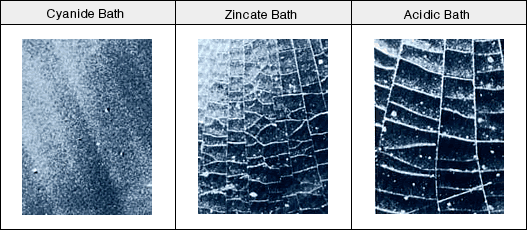#130 Zinc Plating
The zinc plating has been widely used as anti-corrosion plating for steel for a long time. Notably, in recent years it has been in ornamental use as well due to the advancements on plating baths and chromate processes have greatly improved not only the anti-corrosion properties but external appearance performances.
Also, the zinc plating is known for its good economy because it is possible to implement tumble plating easily.
Usual plating, called "Stationary Plating", uses racks (fixtures) to hold the objects to submerge in the plating bath to apply the DC current. On the other hand, with the Tumble (Barrel) Plating, the objects are placed in either a vertical or a horizontal barrel and tumbled and the electrical current is applied. The objects travel within the barrel while conducting the electrical current with each other. Therefore, the racks and racking of objects are not needed with tumble plating, offering great savings in power and labor.
Let us first look at the types of zinc plating.
[Table] Zinc plating bath types and characteristics
|
The coating properties of each zinc plating bath differ. The Erichsen test shows the hardness of the coatings which become the issue on post plating workability. The cracks mean that the coatings are harder.

- Environmental conservation
- Hot Dipping
- Anodic Oxidation Process
- Anodic oxidation treatment
- Anodizing
- Corrosion - Corrosion Protection
- Electroless Plating
- Electroplating
- Heat treating
- Hydrogen embrittlement
- Metal cleaning
- Metal etching
- Painting
- Special paints
- Surface Treatment
- Surface-treated steel sheets
- Thermal Spraying



